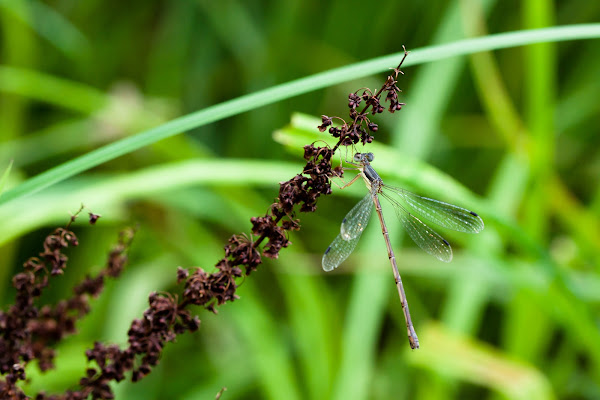Summary: North American slender spreadwing damselfly habitats from Manitoba and the Rockies to Nova Scotia and Florida get blue stripes, thin bodies, yellow veins.
 |
| slender spreadwing damselfly (Lestes rectangularis) at Mason Neck, southernmost Fairfax County, Northern Virginia; June 24, 2017: Judy Gallagher (judygva), CC BY 2.0 Generic, via Flickr |
North American slender spreadwing damselfly habitats agitate arborists, gardeners, naturalists and tree stewards in vegetated, wet woodland distribution ranges eastward from Manitoba and the Rockies to Atlantic coastlines, Nova Scotia through Florida.
Slender spreadwings bear their common name because of long-, slim-bodied looks and the scientific name Lestes rectangularis (robber [with] rectangular [shapes when claspers viewed from above]). Common names consider the consensus of scientific committees convened by the Dragonfly Society of the Americas for damselflies and dragonflies in Central, North and South America. Descriptions in 1839 by Thomas Say (June 27, 1787-Oct. 10, 1834), world-famous naturalist from Philadelphia, Pennsylvania, and specialist in insects, reptiles and shells, define scientific designations.
Slender spreadwing damselfly lifespans expect sand-bottomed, shady, slow-moving bays, lakes, marshes, ponds and streams and vernal pools with emergent vegetation in or near forests and woodlands.
April through October function as maximum, most southerly flight seasons even though September furnishes wildlife mapping opportunities throughout all coastal, eastern, Great Plains and midwestern niches.
Slow-moving slender spreadwing damselflies go frequently to low perches on stems in dense, shaded, sheltered, tangled herbaceous and shrubby waterside vegetation and infrequently over open waters. Females and males hunker down at respectively more and less hidden oblique angles to low-lying, non-woody stem and woody branch perches and roosts in plant-rich wetlands. They impel themselves from immobility, not to glean grounded, immobile invertebrates or to hawk back and forth after winged prey but to sally after opportunistic passers-by.
Ants, biting midges, ducks, falcons, flycatchers, frogs, grebes, lizards, robber flies, spiders, turtles and water beetles, bugs and mites jeopardize North American slender spreadwing damselfly habitats.
Immature slender spreadwing damselflies keep to dull, faded, light, pale colors and small sizes and never know age-related, blue, gray, white powdery-looking waxy blooms from cuticles.
Wetlands launch egg-hatched, multi-molted, woodland-living larvae, naiads or nymphs during two- to three-week teneral emergences into two-week color and one-week sexual maturations for maximum six-week adulthoods. Adults maintain mid-afternoon matings in woodlands away from water, before females manage one incision per egg into cattail stems one foot (0.31 meter) above water surfaces. Pond spreadwing members of the Calopterygidae broad-winged family need aphids, beetles, borers, caddisflies, copepods, crane flies, dobsonflies, gnats, leafhoppers, mosquitoes, rotifers, scuds, water fleas and worms.
North American slender spreadwing damselfly habitats offer season-coldest temperatures, northward to southward, from minus 45 to 20 degrees Fahrenheit (minus 42.77 to minus 6.66 degrees Celsius).
Beech, bellflower, birch, bladderwort, cattail, daisy, grass, greenbrier, heath, laurel, madder, maple, nettle, olive, pepperbush, pine, pondweed, rush, sedge, water-lily and willow families promote slender spreadwings.
Blue-topped, yellow-bottomed eyes, brown-black, dark-ringed, long abdomens, brown-black upper thoraxes, clear, dot-tipped, short wings, pale blue-striped thoracic fronts and tan-yellow lower thoraxes quicken adult female identifications. Adult males reveal age-waxed, black-, blue-, brown- tan-yellow-segmented, long abdomens, black-backed heads, blue eyes, blue-striped, black thoraxes, clear, dot-tipped wings, and yellow lower sides and underparts. Adults show off 1.46- to 2.05-inch (37- to 52-millimeter) head-body lengths, 1.18- to 1.73-inch (30- to 44-millimeter) abdomens and 0.79- to 0.98-inch (20- to 25-millimeter) hindwings.
Similar-looking pond and related stream spreadwings trumpet no blue-striped thoracic fronts, long, slim abdomens or yellow outer-wing veins in overlapping North American slender spreadwing damselfly habitats.
 |
| slender spreadwing damselfly (Lestes rectangularis) at Frick Park, Pittsburgh, Allegheny County, southwestern Pennsylvania; Saturday, Aug. 7, 2010, 16:46: Melissa McMasters from Memphis, TN, United States, CC BY 2.0 Generic, via Wikimedia Commons |
Acknowledgment
My special thanks to talented artists and photographers/concerned organizations who make their fine images available on the internet.
Image credits:
Image credits:
slender spreadwing damselfly (Lestes rectangularis) at Mason Neck, southernmost Fairfax County, Northern Virginia; June 24, 2017: Judy Gallagher (judygva), CC BY 2.0 Generic, via Flickr @ https://www.flickr.com/photos/52450054@N04/35516560845
slender spreadwing damselfly (Lestes rectangularis) at Frick Park, Pittsburgh, Allegheny County, southwestern Pennsylvania; Saturday, Aug. 7, 2010, 16:46: Melissa McMasters from Memphis, TN, United States, CC BY 2.0 Generic, via Wikimedia Commons @ https://commons.wikimedia.org/wiki/File:Slender_spreadwing_(25768834635).jpg; Melissa McMasters (mmcmasters), CC BY 4.0 International, via iNaturalist @ https://www.inaturalist.org/photos/3148987
For further information:
For further information:
Abbott, John C. Dragonflies and Damselflies of Texas and the South-Central United States: Texas, Louisiana, Arkansas, Oklahoma and New Mexico. Princeton NJ; and Oxford UK: Princeton University Press, 2005.
Beaton, Giff. Dragonflies & Damselflies of Georgia and the Southeast. Athens GA; and London UK: University of Georgia Press, 2007.
Berger, Cynthia. Dragonflies. Mechanicsburg PA: Stackpole Books: Wild Guide, 2004.
Bright, Ethan. "Lestes rectangularis Say, 1839: 34 -- Slender Spreadwing." Aquatic Insects of Michigan > Odonata (Dragon- and Damselflies) of Michigan > Zygoptera, Selys, 1854 > Lestidae, Calvert 1901 (Spreadwings) > Lestes Leach, 1815 (Pond Spreadwings).
Available @ http://www.aquaticinsects.org/sp/Odonata/sp_oom.html
Available @ http://www.aquaticinsects.org/sp/Odonata/sp_oom.html
"Lestes rectangularis." James Cook University-Medusa: The Odonata - Dragonflies and Damselflies > Zygoptera > Lestidae > Lestes.
Available via James Cook University-Medusa @ https://medusa.jcu.edu.au/Dragonflies/openset/displaySpecies.php?spid=4500
Available via James Cook University-Medusa @ https://medusa.jcu.edu.au/Dragonflies/openset/displaySpecies.php?spid=4500
Paulson, Dennis. Dragonflies and Damselflies of the East. Princeton NJ: Princeton University Press, Princeton Field Guides, 2011.
Say, Thomas. "Descriptions of New North American Neuropterous Insects, and Observations on Some Already Described: 1. L. rectangularis." Journal of the Academy of Natural Sciences of Philadelphia, vol. VIII, part I: 34-35. Philadelphia PA: Merrihew and Thompson, 1839.
Available via Biodiversity Heritage Library @ http://biodiversitylibrary.org/page/24622985
Available via HathiTrust @ https://hdl.handle.net/2027/umn.31951d01082785z?urlappend=%3Bseq=36
Available via Biodiversity Heritage Library @ http://biodiversitylibrary.org/page/24622985
Available via HathiTrust @ https://hdl.handle.net/2027/umn.31951d01082785z?urlappend=%3Bseq=36
"The 2012 USDA Plant Hardiness Zone Map." The National Gardening Association > Gardening Tools > Learning Library USDA Hardiness Zone > USDA Plant Hardiness Zone Map.
Available @ https://garden.org/nga/zipzone/2012/
Available @ https://garden.org/nga/zipzone/2012/
No comments:
Post a Comment
Note: Only a member of this blog may post a comment.